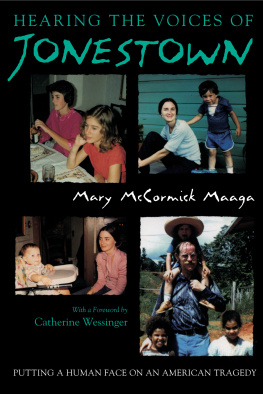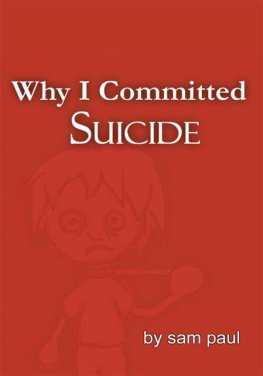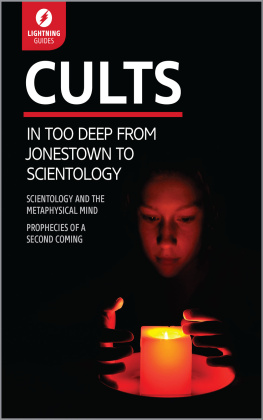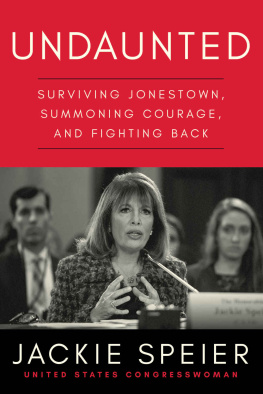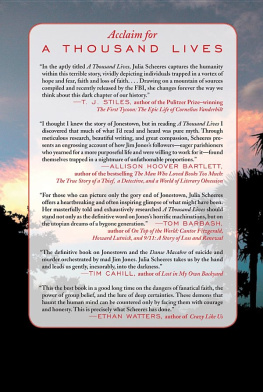Contents
Guide
Page List



Copyright 1998 by Syracuse University Press
Syracuse, New York 13244-5290
All Rights Reserved
First Paperback Edition 2020
202122232425654321
The paper used in this publication meets the minimum requirements of the American National Standard for Information SciencesPermanence of Paper for Printed Library Materials, ANSI Z39.48-1992.
For a listing of books published and distributed by Syracuse University Press, visit https://press.syr.edu.
ISBN: 978-0-8156-0515-7 (hardcover)
978-0-8156-1122-6 (paperback)
978-0-8156-5046-1 (e-book)
Library of Congress has cataloged the hardcover as follows:
Maaga, Mary McCormick.
Hearing the voices of Jonestown / Mary McCormick Maaga ; with a
foreword by Catherine Wessinger. 1st ed.
p. cm. (Religion and politics)
Includes bibliographical references and index.
ISBN 0-8156-0515-3 (alk. paper)
1. Jonestown Mass Suicide, Jonestown, Guyana, 1978. 2. Peoples
Temple. 3. Jonestown (Guyana)Religion. I. Title. II. Series.
BP605.P46M22 1998
289.9dc21 97-45194
Manufactured in the United States of America
Dedicated to my husband, Boikanyo,
with love and gratitude
and to our son, John Desmond Tutu,
with love and hope
Amandla!
Contents
Foreword
CATHERINE WESSINGER
E veryone knows what happened at Jonestown. In 1978, Jonestown was a compound in the jungles of Guyana where over nine hundred brainwashed Americans lived. They were members of a church named Peoples Temple led by an insane, megalomaniac messiah, Jim Jones. After an unwelcome investigative visit by Congressman Leo Ryan, news reporters, and concerned relatives, which prompted some of the residents to defect, Jonestown men opened fire on Ryans departing party killing five people including Ryan. Then the men returned to Jonestown where they joined the other residents in drinking punch laced with cyanide and tranquilizers. Some people were injected with the deadly potion. The children were killed first. People who did not want to commit suicide were forced to do so at gunpoint. Since no sane person would follow a leader so obviously delusional as Jim Jones, we can be certain that the Jonestown residents were brainwashed zombies. Further proof that Jim Jones had a controlling, narcissistic personality is the fact that he sexually exploited the women, and some of the men. The decision to commit murder and mass suicide was made by Jim Jones alone. Jones exercised total control over his followers. Jim Jones is solely to blame for the 922 deaths in Guyana on 18 November 1978.
The Jonestown myth is at once frightening and reassuring. It is frightening because, as we are warned by anticultists, anyone can be brainwashed by an unscrupulous religious leader. It is reassuring, because the Jonestown residents were clearly not in their right minds, since they were obviously subjected to mind control by Jim Jones. We can rest assured that sane people capable of making rational choices do not choose to kill others, their children, and themselves. Furthermore, we do not have to think about all the people of Jonestownthe 260 children, the seniors, the young people, the mature adults. The focus on laying all the blame on Jim Jones makes these people disappear. We do not have to confront them as individuals, who were committed to an ideal, and who possessed the ability to agree with and carry out the murder/suicide plan, and who also had the power to disagree and refuse to carry out those actions. Finally, we can be reassured that the residents of Jonestown were totally unlike ordinary, sane people like ourselves.
Mary McCormick Maaga asserts that the Jonestown residents are the most intimate other, because they were human beings possessing agency, the ability to decide right and wrong, and they shared characteristics with ourselves. By attending to the voices of the Jonestown residents, who have been ignored due to the focus on Jim Jones, Maaga has found evidence that contradicts the received myth about Jonestown. The reality of Jonestown is more complex than what anticultists and the media have led us to believe. Jonestown had both good and bad features. Its residents were active in making the decision to carry out the mass murder/suicide, especially the young college-educated white women in Jim Joness inner circle. Maaga questions the patriarchal assumptions that have been made about Jim Joness mistresses, and she listens to their voices. According to their testimony, through their relationships with Jim Jones, these young women found themselves empowered to actively improve the world and achieve concrete results involving social justice. These women loved Jim Jones, but they loved the cause even more. For reasons described by Maaga, the power of Jim Jones in fact declined in Peoples Temple after he left California for Jonestown. Jonestown documents demonstrate that the residents participated in making the decision to commit mass suicide if enemies threatened their collective, but the young women leaders and key men were most involved in making and facilitating that decision.
Religious commitment involves having an ultimate concern, a goal that is the most important thing in the world for the believers (Baird 1971, 18). People may change their ultimate goals at different points in their lives, but sometimes individuals and groups may be so committed to an ultimate concern that they are willing to kill or die for it, or to do both. Early Christian martyrs are revered for dying for their faith, but today in America, we usually regard such people as fanatics, not as saints and heroes. The residents of Jonestown died in order to preserve their ultimate concern, their loyalty to each other as members of a socialist collective. Their ultimate concern was to preserve the unity of their community at all costs.
Although Jim Jones rejected the Bible, he articulated his teachings in the idiom of Protestant and Pentecostal Christianity. He termed his doctrine apostolic socialism. Peoples Temple members were attempting to live out Jesus injunction to love and care for the poor, the sick, and the downtrodden. Jonestown was a multiracial community committed to overcoming racism, sexism, ageism, and to helping everyone in need who came their way. They had withdrawn to Jonestown in Guyana as a refuge where they would be safe during the imminent apocalypse that would destroy the old sinful capitalist world and clear the way for communists to make a new world upholding human dignity and justice.
I have suggested that we use the term catastrophic millennialism for this ancient vision of the old world being violently swept away so that a collective salvation, a millennial kingdom, can be constructed (Wessinger 1997). A noteworthy feature of catastrophic millennialism is its dualism. Dualism is a perspective that divides reality into good vs. evil, us vs. them. A dualistic way of looking at the world is not only a common characteristic of cultists, but also of ordinary people.
The Jonestown residents and the anticultists who opposed them were locked in a war fed by the dualistic worldviews of the participants on both sides. The anticultists were successful in enlisting the cooperation of federal agencies and officials, the media, and thereby public opinion in their project to destroy Jonestown. This degree of cultural opposition (Hall 1995) happened to occur at a time when Jonestown was suffering from internal weaknesses, including some caused by Jim Jones himself.
Next page
